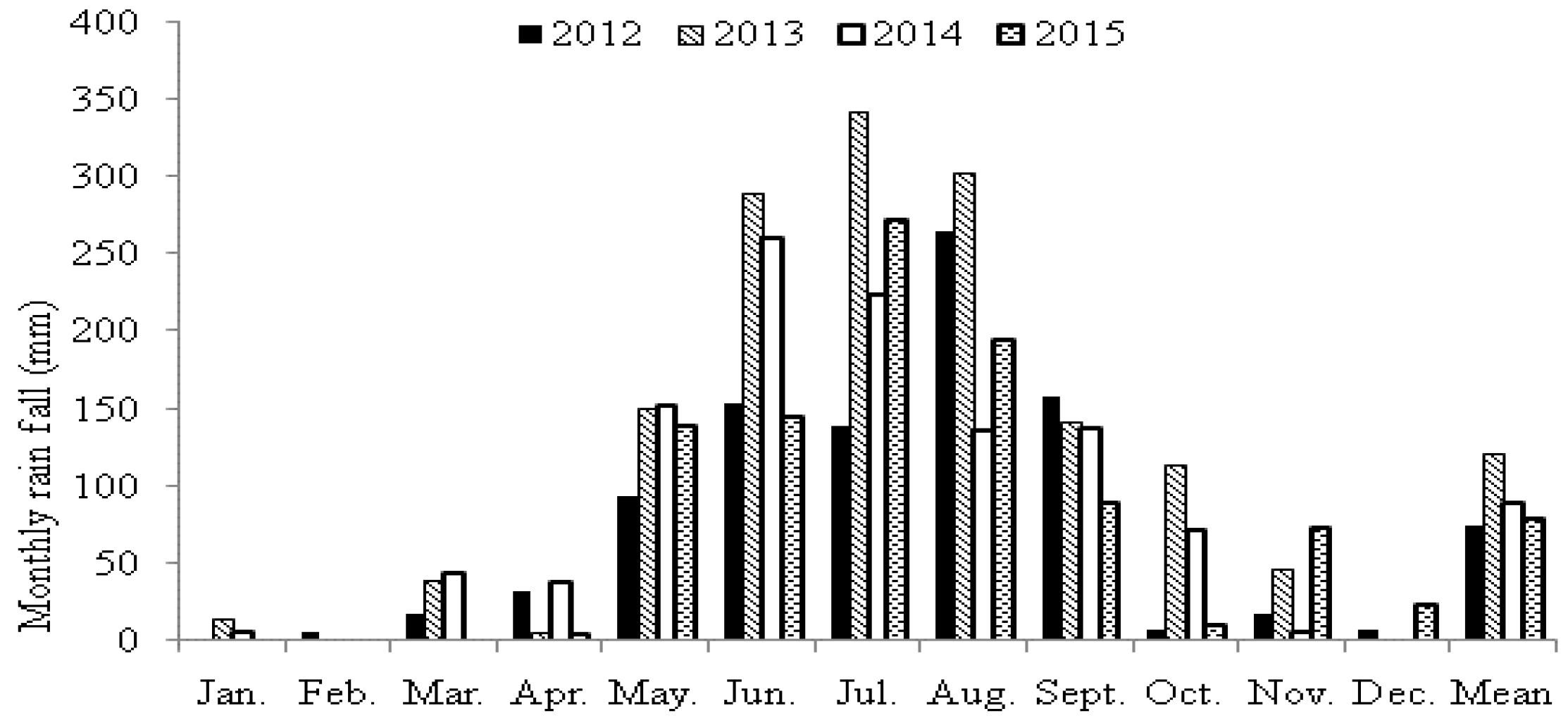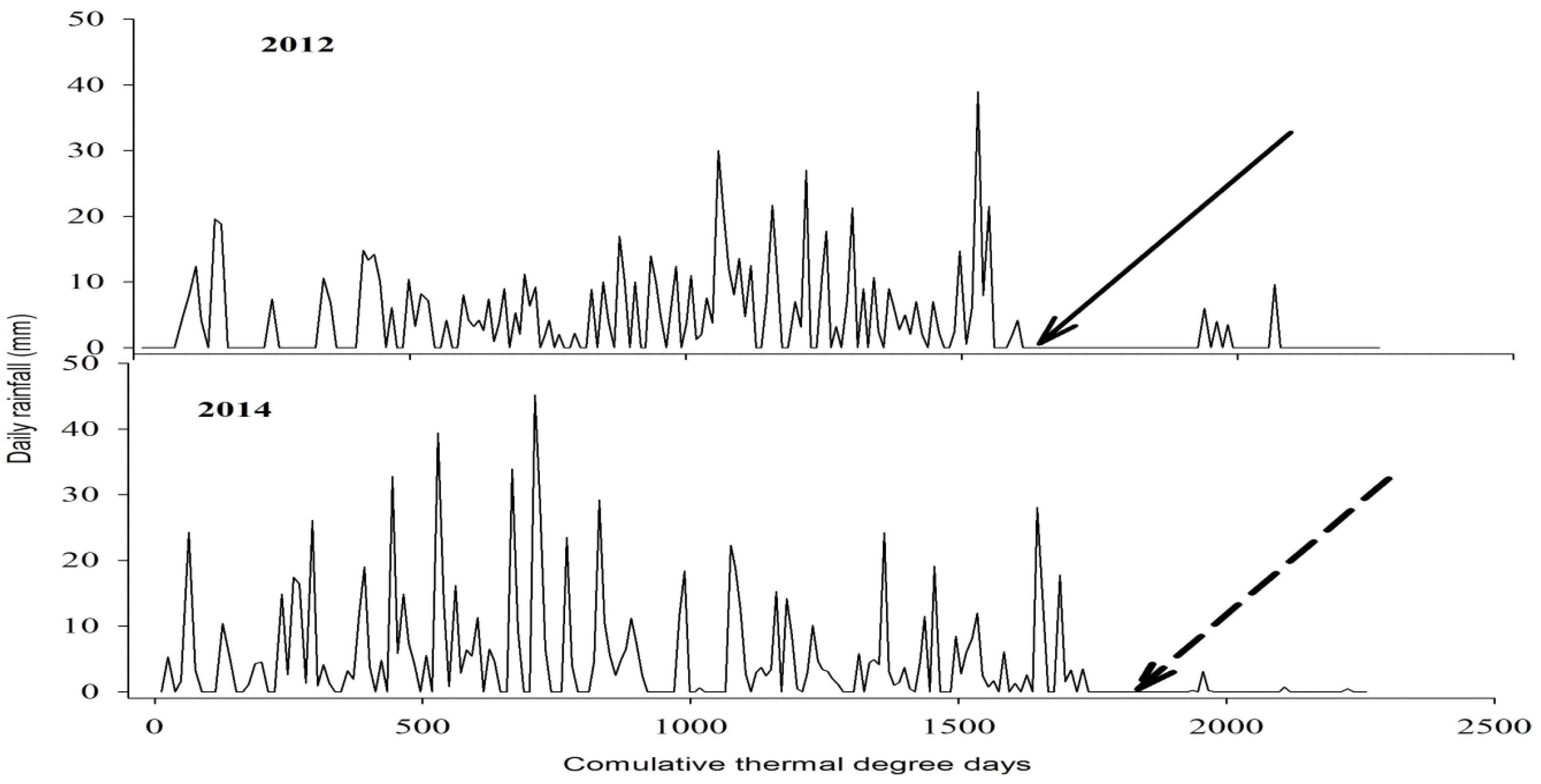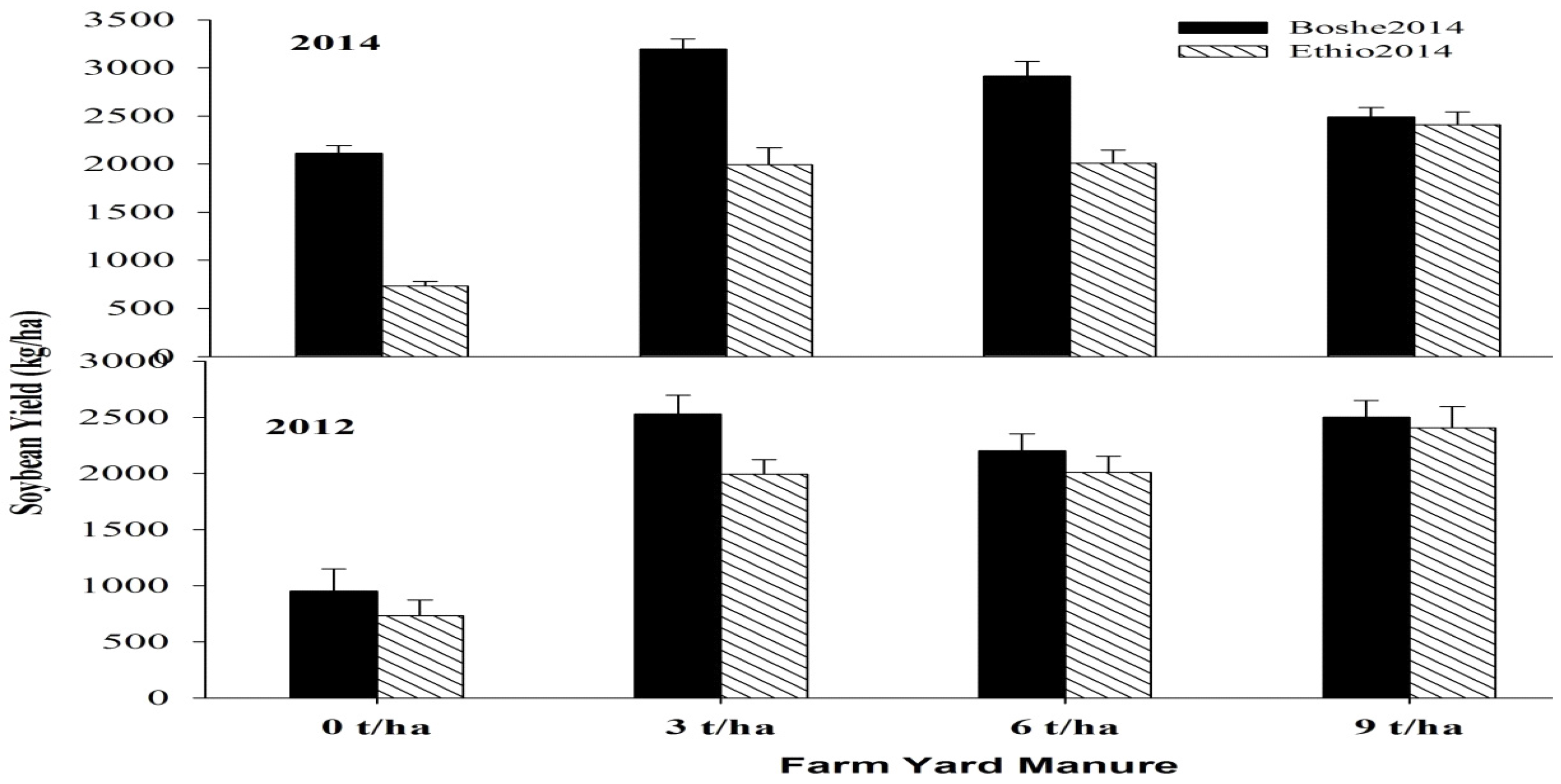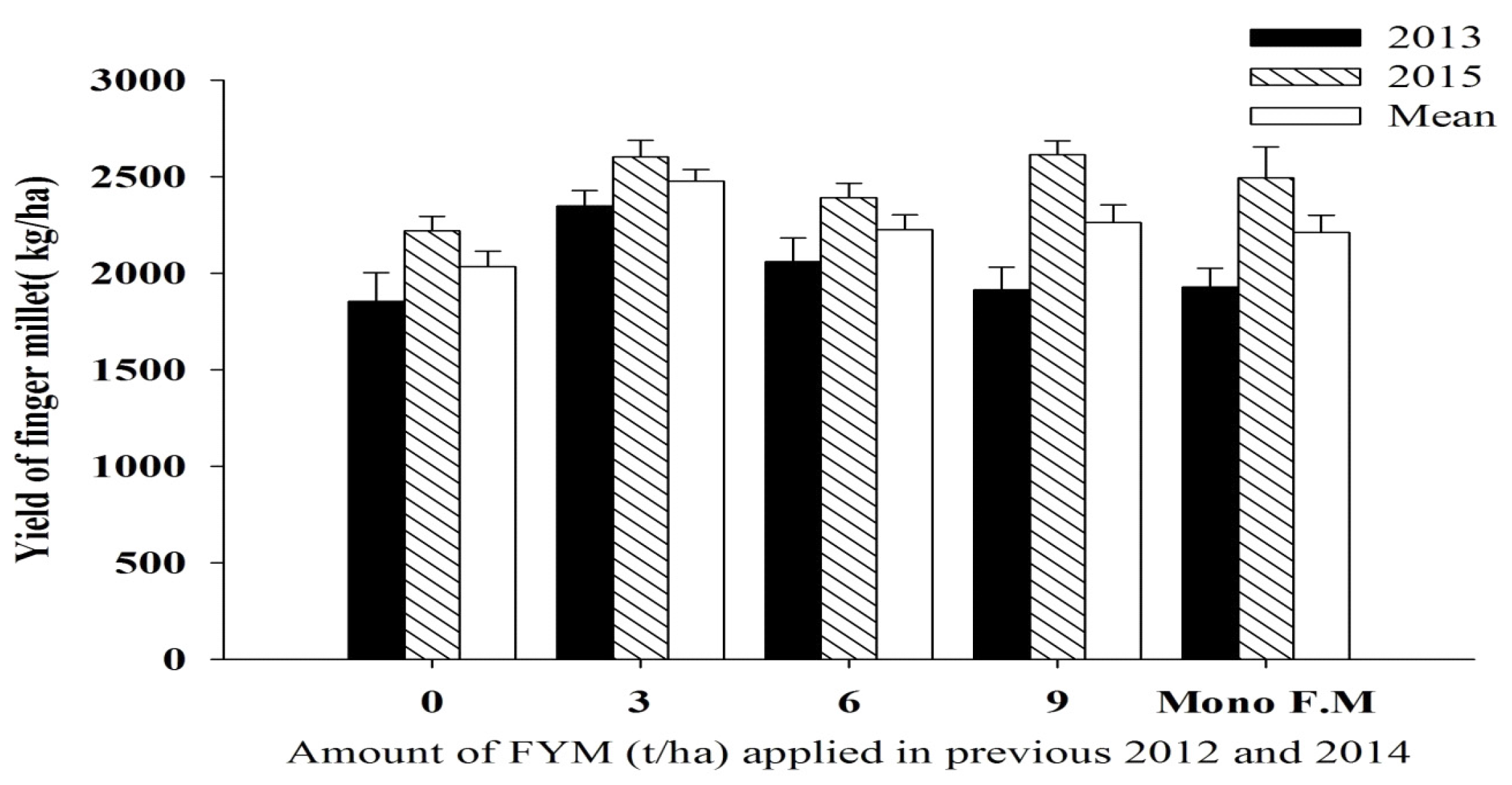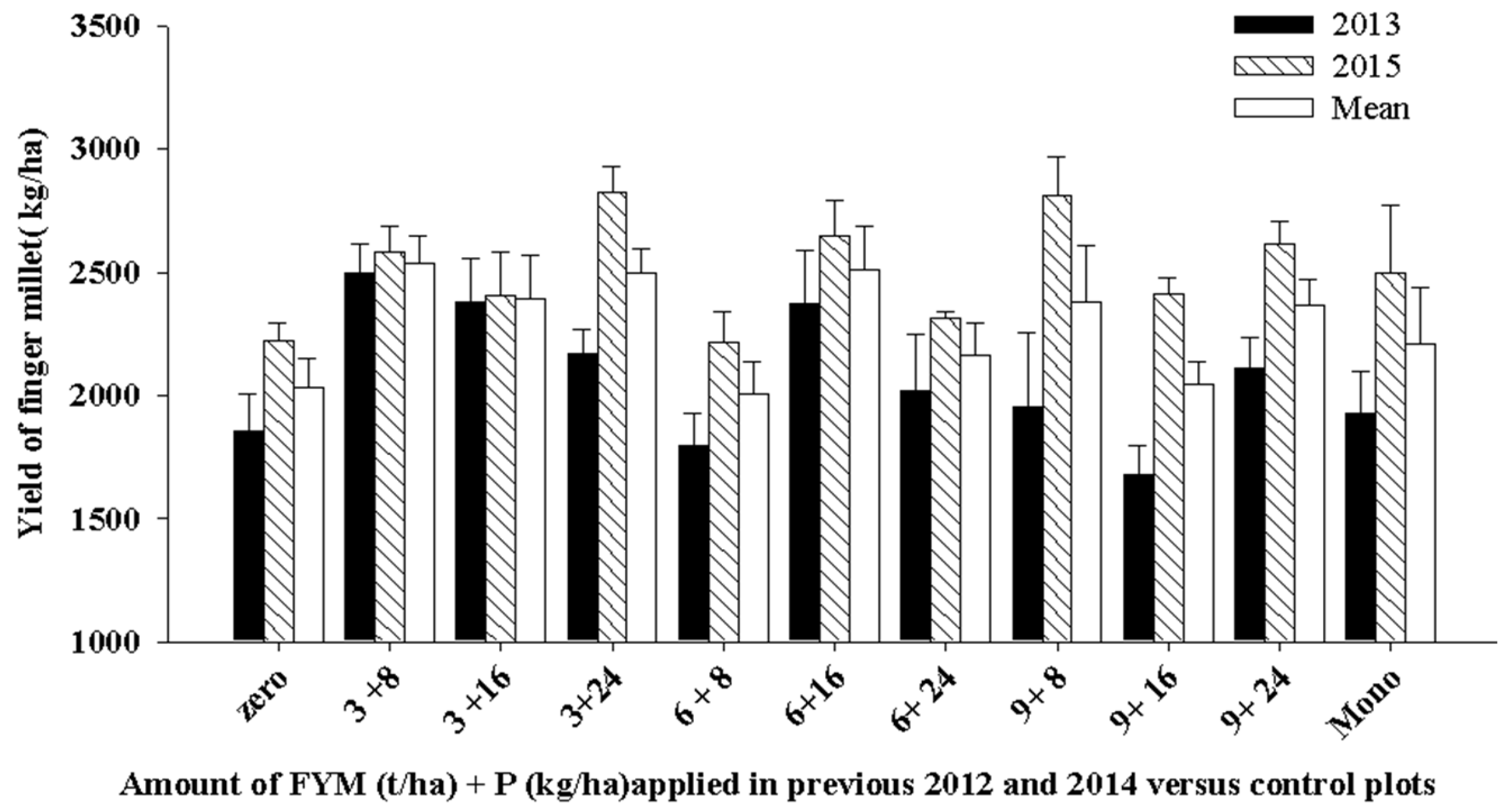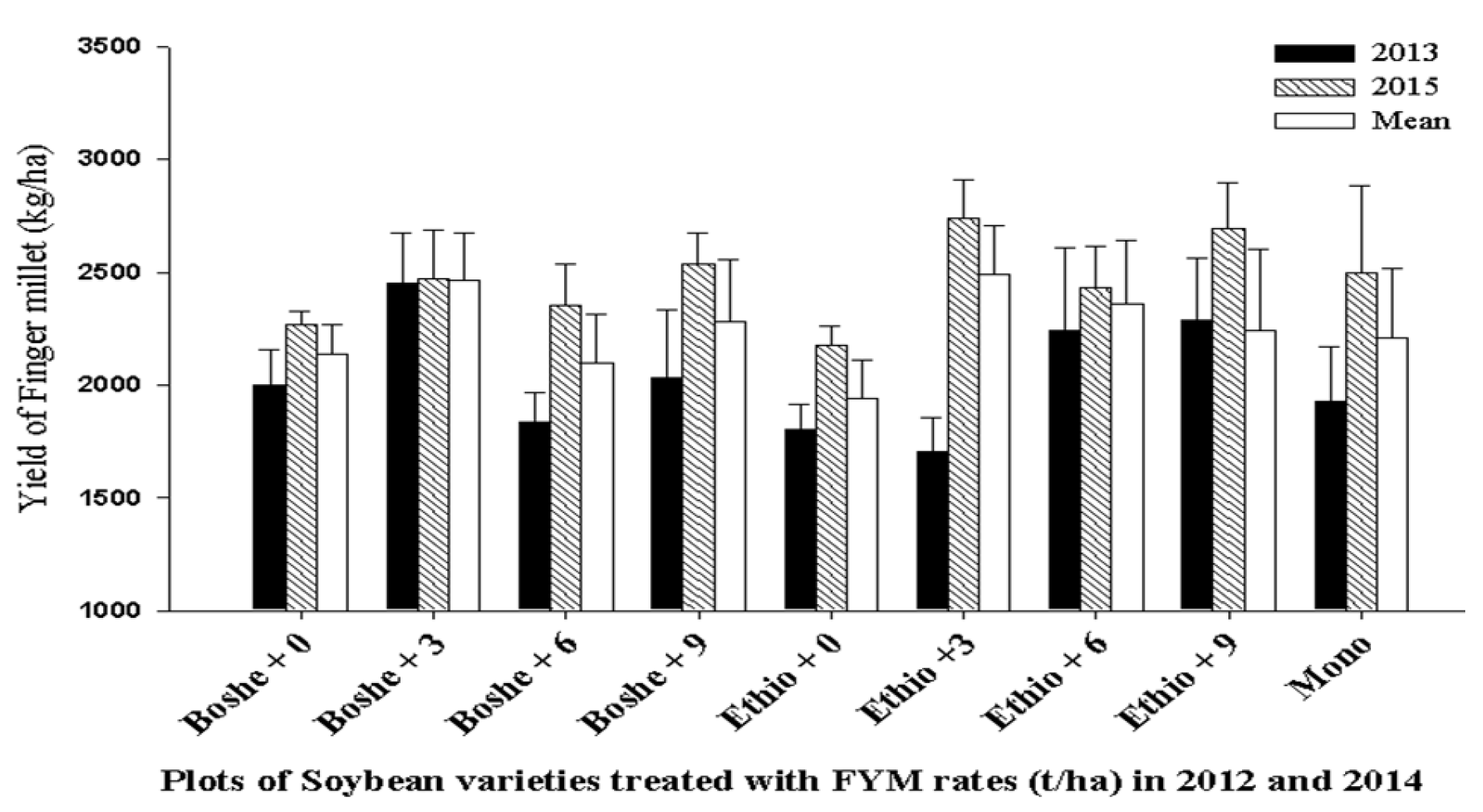The analysis of variance revealed that seasonal variations highly affected (
p < 0.001) yield performance of soybean varieties in combination with the integrated fertilizer application (
Table 2). These significant variations were due to high rainfall variability in each season and to the soil fertility dynamics of the experimental site. Therefore, comparison of treatment means was done for each cropping season individually. Even though the soybean varieties were significantly different in their yield performance, significant interactions were observed between the varieties and applications of FYM and P (
Table 2).
Since seasonal variations significantly affected the performance of the crop, the overall mean for each season indicated that significantly less yield was obtained in the 2012 (2060 kg/ha) season as compared to 2014 (2760 kg/ha). Overall, a 33% yield reduction was observed in the short rainy season. The main reason for the yield reduction in 2012 was due to the cessation of rainfall from the time of pod setting to near to physiological maturity (
Figure 2). Moreover, the annual rainfall amount in this season was 866 mm, whereas it was 1067 mm in the 2014 cropping season. Correlation between yield and annual rainfall for the cropping seasons also showed a strong positive correlation (
R2 = 0.96), indicating that the yield could be highly affected both by the amount of rainfall and by its distribution. This effect of moisture stress at a critical stage of the soybean crop led to forced maturity and to a significant reduction in its potential yield in accordance with other studies [
22]). In the same report, it was shown that a significant lack of water during flowering to pod setting leads to physiological changes in the plant, such as stomatal closure and leaf rolling, and consequently, premature fall of flowers and leaves and pod abortion, which ultimately results in yield reductions [
22].
In addition, the application of organic manure significantly enhanced soybean yield as compared to the control treatment. Significant yield increases over the control were recorded by 192% in 2012 and 84% in 2014 (
Figure 3). Corroborating these results, other finding indicated that organic manure supplies nutrients throughout the season for the growth and development of the crop, in addition to improving soil moisture holding capacity and, hence, increased productivity [
3].
In the 2012 cropping season, the highest significant yield was obtained from the Boshe variety when treated with combined application of 9 t FYM /ha and 24 kg P/ha followed by the treatment combination of 3 t FYM/ha and 24 kg P/ha (
Figure 4). Application of 6 t FYM/ha with 16 kg P/ha also significantly increased grain yield as compared to other treatment means (
Figure 4). In general, for the Boshe variety, a 100–200% yield increase was obtained with a combined application of organic and inorganic fertilizers when compared to the control.
Similarly, Ethio-ugozilavia yields were the greatest with the highest application rates of FYM (9 t/ha) and P (24 kg/ha). A linear increase yield was observed when 9 t FYM/ha were applied with increased rates of P in 2012 (
Figure 4). This result in agreement with another research finding shows that the yield could increase further with the application of higher doses of the organic manure and inorganic fertilizer since it could enhance soil moisture holding capacity in the short rainy season, in addition to soil fertility improvement [
24]. In other studies, it was shown that high manure applications significantly reduced soil water evaporation throughout the growing period as compared to the controls and significantly increased soil water storage capacity; hence, it was advised to apply during the dry or short rainy seasons [
23].
In the 2014 cropping season, the response of the soybean varieties to combined applications of organic and inorganic fertilizer were different compared to that of 2012 (
Figure 4). The highest significant yield from the Boshe variety was attained at the combined application of 6 t FYM/ha and 8 kg P/ha followed by the combination 3 t FYM/ha and 24 kg P/ha. The combination of lower rates of both fertilizer sources (3 t FYM/ha and 8 kg P/ha) showed a similar effect on yield performance with that of the highest rates, but resulted in a 53% yield increase over the control. Likewise, the Ethio-ugozilavia variety showed the highest yield performance when 3 t FYM/ha was applied with 16 kg P/ha and 8 kg P/ha, which resulted in a respective yield increase of 100% and 81% over the control (
Figure 4). This result indicate that medium or late maturing types of soybean compete for the resources differently due to the differences in the length of their growing period and other growth characteristics. Ronner et al. [
14] also showed that varietal differences in nodulation capacity, root growth and development and the capacity of the nutrient sink resulted in different resource use. The current result also confirmed that with sufficient rain (2014), lower doses of organic fertilizer combined with optimum doses of inorganic fertilizers significantly enhance crop productivity. This might be due to optimum moisture and temperature that might contribute to high decomposition rates of organic manure and in the release of nutrients for the crop. However available phosphorus might not be quite enough for the growth of the crop [
25].
3.1. Soil Fertility Status after Soybean Harvest
The result of the analysis of variance revealed that soil pH, organic carbon, total nitrogen and available phosphorus were highly (
p < 0.01) varied across cropping seasons (
Table 3). However, no significant effects for each observed parameter were recorded with respect to the main effects and their interaction of the three factors. The observed seasonal variation may be due to the history of soil fertility of the experimental sites, which were selected from the different sites at the Bako research site. The result of the initial soil analysis also confirmed that there were considerable variations in soil chemical properties (
Table 1). For instance, the total nitrogen of the site was significantly varied and found in the low (2012) and medium (2014) ranges.
In the 2012 cropping season, soil pH after soybean harvest ranged from 5.2–5.7, which was moderate to strongly acidic (
Table 4). Application of FYM did not significantly affect the soil pH though there is a slight increase when compared to the control plot. This might be due to buffering capacity of the organic matter by releasing some organic compounds that fix H
+, AL
+3 and other cations [
25]. Soils with a high amount of organic matter due to the addition of organic materials have high cation exchange capacity (CEC) and buffering capacities to stabilize soil pH [
10]. Organic carbon and nitrogen content also showed little variation due to treatment applications (
Table 4), but as per the classification, these values are found under moderate ranges [
26] Since rainfall amount and distribution over the season (2012) were unexpectedly very low, decomposition rates of applied organic manure and soybean litter fall might be considerably affected, and hence, the buildup of soil organic matter may have temporarily been decreased [
25,
27].
On the other hand, there were slight improvements of the organic carbon content due to the precursor crop and combined application of the fertilizers. For instance, the early type of soybean precursor with combined application of 9 t FYM/ha and 16 kg P/ha increased the organic carbon content of the soil by 16% compared to the result obtained before planting (
Table 1). The available phosphorus was also found in the low range, which could be due to the lower soil organic matter status and available phosphorus of the experimental soils, which were dominated by the HPO
42− anion found in strongly acidic soils [
10,
27].
In the 2014 cropping season, however, the soil chemical properties of the experimental site after soybean harvesting were completely different as compared with 2012 due to differences in the rainfall amount and distribution that might have affected organic matter decomposition. Soil pH ranged from 4.4–4.6, which is strongly acidic (
Table 5). Organic carbon content of the soil was slightly improved due to the application of organic manure as compared to the control [
27,
28]. For instance, application of 9 t FYM/ha with various rates of phosphorus resulted in organic carbon content ranging from 2.7–3.1%, which was increased by 5–19% over the control plot, respectively. Growing of soybean even without fertilizer application improved organic carbon of the soil by 13% compared with the value observed prior to planting (
Table 1 and
Table 5). This improvement of soil fertility might be due to a suitable soil environment, such as optimum moisture and temperature, which determine the rate of organic manure decomposition and soybean litter fall and nutrient release from crop residues [
29,
30,
31]. For instance, organic carbon of the soil after soybean harvest in 2012 was 1.63%, whereas it was 2.60% in 2014, showing a direct correlation with annual rainfall (
Table 1 and
Table 5). Similarly, total nitrogen content of the soil varied from 2.26–2.29%, which is categorized in the high range.
3.2. Finger Millet Performance due to Residual Effects
The yields of finger millet as influenced by the residual effects of the precursor soybean crop showed highly significant (
p < 0.01) differences due to seasonal variations, FYM and the interactions among varieties and chemical fertilizer rates (
Table 6). There was also a three-way interaction, though not strongly significant. Even though seasonal variations might influence the yield of finger millet, variations in land history of the experimental site (
Table 1) and soil fertility status after combined application of the fertilizers to soybean in 2012 (
Table 3) and 2014 (
Table 4) might have contributed to significant differences in the yield performance of the subsequent finger millet.
In the 2013 cropping season, the significantly higher yield of finger millet was obtained when sown on a previous (2012) soybean plot that received 3 t FYM/ha as a main effect followed by 6 t FYM/ha (
Figure 5). This might be due to gradual decomposition of organic manure that slowly releases nutrients for subsequent crops [
3,
32]. However, high doses of organic fertilizer application in the short rainy season might take more time to be decomposed and converted to soil organic matter. This could be due to the limited population of decomposing micro-organisms and their nutrients, particularly nitrogen, and other soil environmental factors that may hamper rapid decomposition of the manure. However, in the long run, higher doses of the manure may provide adequate nutrients for the following crop rotation [
30,
33]. Interestingly, the precursor soybean crop without fertilizer application significantly increased the yield of the subsequent finger millet, which is statistically on par with yields obtained from the mono-cropping practice (farmers’ practice with no rotation) that received recommended fertilizer applications (20 kg P/ha). This may indicate that soybean litter fall has the potential to rapidly decompose and increase soil organic matter, while it can also enhance the availability of nitrogen and other nutrients [
34,
35].
Evidently, finger millet yield showed respective yield increments of 6% and 22% when planted following soybean precursor with 3 t FYM/ha and 6 t FYM/ha compared with farmers’ practice, and similar results were also reported by Hemalatha and Chellamuthu [
30].
In the 2015 cropping season, however, the yield performance of finger millet was significantly higher by 20% as compared with the yield obtained in 2013 (
Figure 5). This might be attributed to variations in soil fertility status after soybean harvest, though the rainfall amount and distribution during the growing of the two seasons were almost similar. In other words, the residual effects of soybean precursor (that produced higher biomass and dropped as litterfall, which may enhance the soil fertility) and fertilizer applied in 2014 considerable enhanced the yield of the following finger millet obtained in 2015 compared to 2013. The residual effect of the different rates of FYM on the following finger millet yield did not show significant difference among the means, though there were slight yield increases when compared with the treatments of farmers’ practices and soybean precursor receiving no fertilizer (
Figure 5). These results indicate that 100% of the chemical fertilizer cost could be saved when finger millet is rotated with soybean precursor crops with the application of organic manure, which is in agreement with a previous finding [
24].
The interaction effect of organic manure with chemical P fertilizer applied to the soybean crop significantly affected the performance of the subsequent finger millet (
Figure 6). In 2013, the significantly variable response of finger millet was observed due to the residual effects of organic manure combined with inorganic P fertilizer [
6]. The highest finger millet yield was obtained when planted on the plot from which soybean that received 6 t FYM/ha in combination with 8 and 16 kg P/ha was harvested. In this case, yield increase over the farmers’ practices was up to 30%. Moreover, the effect of the soybean precursor even without fertilizer use considerably increased the yield of the following finger millet, which is statistically on par with the yield obtained from the farmers’ practice.
In the 2015 cropping season, the highest yield of finger millet (2825 kg/ha) was obtained when planted on soybean precursor plots that received 3 t FYM/ha with 24 kg P/ha followed by 9 t FYM/ha with 8 kg P/ha, which are statistically on par (
Figure 6). Similar to the result of 2013, the yield of finger millet was at statistical parity when planted following soybean precursor without fertilizer use as compared with farmers’ practice, and a similar result was also reported by Bado et al. [
15].
The interaction of residual effects of soybean varieties, due to nitrogen fixation and crop litterfall, and the application of FYM significantly influenced the yield of the succeeding finger millet (
Figure 7). In 2013, the highest yield of finger millet was obtained when planted on the plot of the precursor Boshe variety, which received 3 t FYM/ha. This result indicates that during the short rainy season, the early maturing soybean type produces biomass that contributes to soil organic matter through litter fall drops (2012) and hence to soil fertility improvement [
12]). Moreover, this result is in line with other research findings indicated that the lower rates of applied FYM also more easily decompose during the short rainy seasons and release some nutrients for the next crops as compared with the higher doses [
11].
In 2015, however, the late type of precursor soybean (Ethio-ugozilavia) with the application of higher doses of 6 and 9 t FYM/ha resulted in a significantly increased yield of the subsequent crop as compared with yield obtained in the 2013 (
Figure 7) with a 22% and 18% yield increase, respectively [
36]. These results revealed that with a good rainy season and under optimum soil conditions, a late type of soybean precursor crop may produce more biomass, and hence, higher litter fall would be dropped and decomposed in the soil.
Moreover, the higher doses of organic manure might be more easily decomposed due to adequate soil moisture during good rainy seasons. Other soil environmental factors such as the soil N:C ratio might also contribute to higher microbial populations that decompose the organic manure more rapidly [
1], increasing the nutrient availability for the next crop in the rotation (
Table 4 and
Figure 7). However, planting of finger millet following a soybean precursor crop that received the 3 t FYM/ha resulted in comparable yield to those obtained by the following farmers’ practices. Thus, the alternative use of FYM could save 100% of the cost of chemical fertilizer inputs and hence can be recommended especially for poor farmers that have access to the sufficient amounts of FYM. On the other hand, the use of a late type soybean precursor crop even without fertilizer application resulted in a greater than 29% yield increase of the subsequent finger millet crop when grown under moderate soil fertility and adequate annual rainfall conditions (2014) as compared to a combined short rainy season (2012) and a low soil fertility status.
